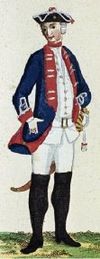Old Prussian Infantry Regiment No. 9 (1806)
The infantry regiment with the later number No. 9 was an old Prussian regiment on foot, which was formed in 1646 as the Minden garrison. It was located in the Brandenburg-Prussian enclave of Grafschaft Mark .
Garrison, replacement and social conditions
The regiment was from 1763 with six companies in Hamm (Westphalia) , with six companies in Soest . Before that, the regiment also had garrisons in Unna (until 1756), Minden and Lippstadt . The districts of Hamm , Hörde , Wetter and Altena replaced the regiment . Furthermore, conscripts from the cities north and south of the Ruhr had to serve, as well as from Soest and the Soester Börde . As was customary in the 18th century, the soldiers were not housed in barracks, but in private quarters, where they also had to do sideline jobs because of the low wages. In 1775 the troops consisted of 40% foreigners and 60% cantonists. Of the foreigners, 2% came from countries outside Germany, 15% from non-Westphalian imperial territories. The Prussian theologian Rulemann Friedrich Eylert condemned the regimental conditions in the Westphalian regiments: “These were usually stray people who had learned nothing else and chose the soldier class because they were given their daily bread in order to eke out their lives and at least, albeit meagerly, their bread have nothing else to do. "
evaluation
The regiment was one of the average good regiments in the Seven Years' War . Friedrich II described his two Westphalian regiments (later No. 9 & 10 ) as "rough but reliable". The regiment was "worn out" especially in the "Russian battles" Kunersdorf and Kay and was rarely used primarily, but nevertheless retained the benevolence of the king.
Whereabouts and succession
The association was dissolved as a regiment "von Schenk" on October 16, 1806 during the Fourth Coalition War through the surrender near Erfurt .
Uniform, equipment
Until the middle of the 18th century, the regimental uniform consisted of a blue uniform jacket with red lapels. There were white bows on the red bush lapel and the round open cuffs. The grenadiers' cap was red, gold brass fittings with a yellow-red tuft. The regimental flag was light green with red flames.
Regiment chief Karl Friedrich von Wolffersdorff 1763–1781 in officer's uniform
See also
literature
- Hans Bleckwenn : The Frederician uniforms: 1753–1786 . In: The bibliophile paperbacks . No. 444. Hardenberg, Dortmund 1984, ISBN 3-88379-444-9 (license from Biblio-Verlag Osnabrück as: The Old Prussian Army. Part 3, Vol. 3, 4 and 5). Volume I, pp. 85ff.
- Rulemann Friedrich Eylert : Between Hamm and Potsdam, Selected reprint of the character traits and historical fragments from the life of the King of Prussia Friedrich Wilhelm III. edited by Jürgen Kloosterhuis (= sources and writings on military history, volume 1). Publisher M. Hüttemann, Paderborn 1989.
Web links
- Private homepage of the Association of Prussian Regiment on foot from Quadt (N ° 9) - Reenactment
- Private English-language project on the Seven Years War: Here No.9

